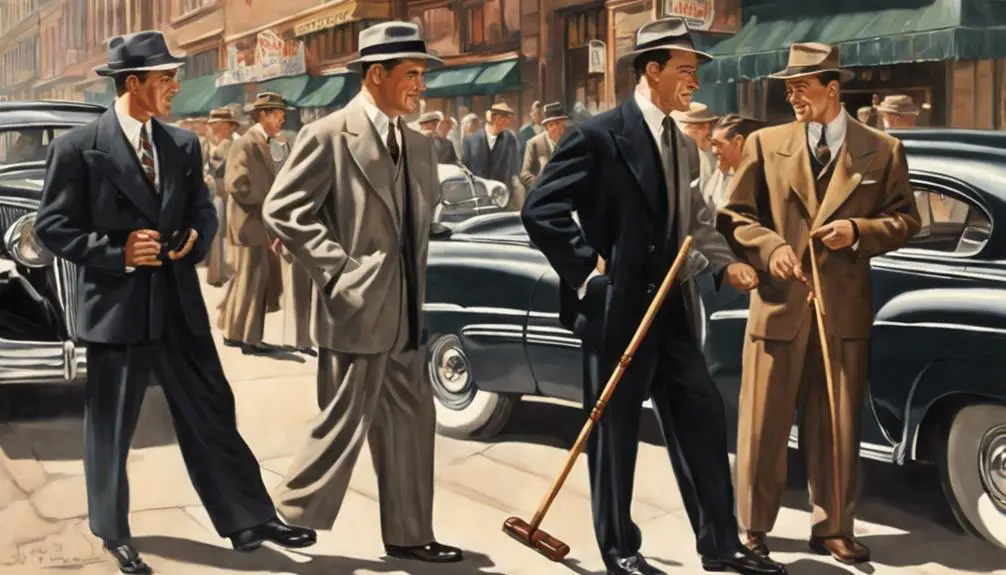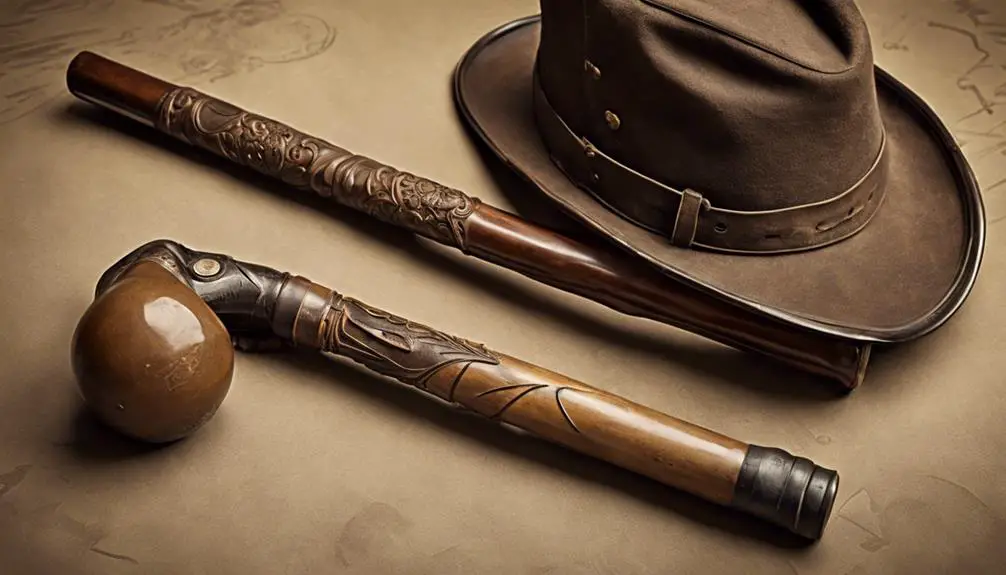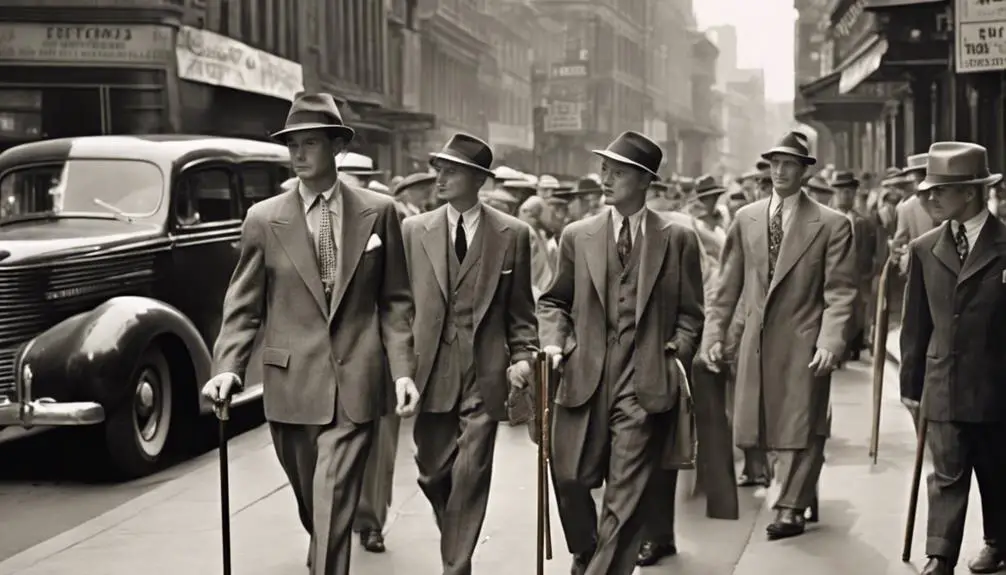In the 1940s, men's walking canes evolved remarkably, merging style with practicality. You'd see beautifully crafted wooden canes adorned with intricate carvings and brass handles, embodying sophistication. The Malacca cane became a popular choice for its lightweight durability. Post-WWII, canes shifted from luxury items to essential tools, often featuring multi-functional designs. Scarcity of materials fueled innovative craftsmanship, leading to simpler yet stylish options. Canes weren't just for walking; they reflected personal taste and social status. Explore more about their designs, cultural significance, and the impact of wartime on this elegant accessory.
Historical Context of Canes

In the 1940s, canes were more than just mobility aids; they embodied a blend of style and functionality that reflected the era's cultural shifts. Walking canes evolved from practical tools to stylish accessories, often showcasing intricate craftsmanship. You'd find wooden canes hand carved with vintage designs, highlighting the artistry of the time. Many featured ornate brass handles that added a touch of swagger and sophistication.
As World War II influenced societal norms, the popularity of canes began to decline, altering their status from luxury items to everyday essentials. While canes were once seen as status symbols, they increasingly served practical purposes for mobility. Nevertheless, the historical context of the 1940s canes still captured artistic influences and cultural trends, making them valuable antiques today.
The unique designs of these canes reflected mid-20th century art styles, often incorporating exotic materials like ivory alongside traditional wood. Collectors now seek these vintage pieces for their aesthetic appeal and historical significance. Understanding the evolution of canes during this period reveals how they mirrored broader societal changes and personal expressions of identity.
Popular Styles and Designs
Walking canes in the 1940s showcased a remarkable blend of artistry and practicality, capturing the essence of men's fashion during the era. These walking sticks often featured unique handles crafted from materials such as brass and natural wood, reflecting personal style and social status. The designs were not only functional but also served as fashion statements, enhancing a man's swagger in social settings.
Here are three popular styles of canes from that time:
- Malacca Cane: Known for its lightweight and durable properties, this cane was made from the malacca palm, making it a favored choice.
- Carved Wooden Cane: These antique canes boasted intricate carvings, showcasing skilled craftsmanship with decorative motifs and geometric patterns that highlighted their elegance.
- Ornate Handle Canes: Featuring handles shaped like animal heads or other Victorian style elements, these canes often included hidden compartments or even weapons, appealing to the adventurous spirit of the era.
Incorporating these elements, canes of the 1940s became more than just walking aids; they transformed into expressions of individuality and refinement.
Influence of WWII on Canes

How did WWII reshape the world of walking canes? The conflict brought significant changes, pushing the focus toward practicality and functionality. Many walking sticks transformed into versatile functional items, such as pool cues. Hand-carved canes from Japan, especially those from Okinawa, became popular for their craftsmanship and collectible nature.
The scarcity of materials meant cane makers had to innovate, often using local woods and adopting simpler, practical designs. The 1940s marked a decline in canes as fashionable accessories; instead, they became tools for everyday use.
Here's a table illustrating key aspects of canes during WWII:
| Feature | Description | Example |
|---|---|---|
| Design | Practical, functional | Vintage canes with military themes |
| Materials | Locally sourced woods | Hand-carved canes from Japan |
| Purpose | Multi-functional items | Canes repurposed as pool cues |
| Collectibility | Vintage canes as collectibles | Emblems and wartime themes |
These changes not only reflected wartime needs but also set the foundation for collectible vintage canes that emerged after the war.
Materials and Craftsmanship
During the 1940s, the materials and craftsmanship of men's walking canes underwent notable evolution, reflecting both the era's aesthetic preferences and practical needs. Wood remained the most common material due to its durability and beauty. Canes were often hand-carved, showcasing intricate designs that highlighted the artisan's skill and creativity. You'd find a variety of exotic woods like malacca and mahogany being used, elevating the quality of these antique cane walking sticks.
Here are three key features of canes from this era:
- Functional Elements: Many canes included hidden compartments or collapsible designs, catering to the practical needs of men during World War II.
- Decorative Handles: Solid brass spare tips and silver accents were frequently integrated, enhancing both the functionality and aesthetic appeal of the canes.
- Emergence of New Materials: The introduction of bakelite and lucite offered fresh styles and colors, appealing to a more modern sensibility.
Cultural Significance and Trends

In the 1940s, men's walking canes evolved into more than just practical tools; they became fashionable accessories that reflected personal style and social status. As the cultural landscape shifted, these canes emerged as symbols of sophistication and masculinity, often featured in art and portraiture, underscoring their significance in male attire.
The decade saw a surge in unique designs, with carving and decorative handles becoming popular. These elements catered to a growing interest in personalized fashion statements, allowing men to express individuality through their canes. Wartime culture influenced this trend, prompting craftsmen to utilize various materials due to resource scarcity, showcasing exceptional craftsmanship and artistry in the process.
As a result, collectors began seeking out vintage canes from this era, drawn to their rarity and distinctive designs. This interest contributed to a burgeoning market for antique walking sticks, aligning with the appreciation for items that blend functionality with aesthetic appeal. Essentially, men's walking canes in the 1940s transcended their original purpose, becoming key components of stylish wardrobes and lasting cultural symbols that resonate even today.
Frequently Asked Questions
Why Did Men Walk Around With Canes?
Men walked around with canes for various reasons, including elegance, social status, and practicality. They served as fashion accessories, symbols of refinement, and sometimes hid useful tools, reflecting personal style and societal norms of the time.
When Did Men Stop Using Canes?
Men stopped using canes prominently after World War II, as changing fashion trends and societal norms diminished their status. By the late 1950s, canes shifted from fashionable accessories to practical tools for mobility assistance.
What Is an Old Man Walking Stick Called?
An old man's walking stick is commonly called a cane. It's not just a mobility aid; it often serves decorative purposes, reflecting personal style and social status, enhancing the user's overall appearance and confidence.
Why Did Men Carry Canes During the Gilded Age?
Men carried canes during the Gilded Age to symbolize wealth and social status. Their elaborate designs showcased refinement, while canes served as fashionable accessories, enhancing public personas and sparking conversations in elite circles.




